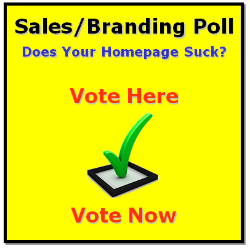Generic Jargon Junkyard
Recently, after judging yet another tech firm’s homepage incomprehensible, I received this mind-numbingly incompetent response from its founder: Branding? Why? Who cares? Do you realize we’re in the B2B [business-to-business] space?
Let me translate her unfortunately typical response:
- Our Website, which nobody reads, merely exists to spew jargon, validate our company’s existence and importance, and catalog our products
- I’ve never worked on commission and don’t understand the art of rapport-building and relationship-based selling
- I’m unschooled in human behavior, face-to-face communications, and the emotions of corporate purchasing
- Branding, whatever that is, is for consumers — so I’ve been told
- Corporate buyers are unemotional robots, willing to inconvenience themselves by:
- demanding, then poring through, lots of data sheets
- wasting time watching videos and reading white papers
- hunting for and surmising the essence of my company and its product
- after all the heavy lifting, “logically” purchasing desired product.
Such ineptitude is typical, the primary reason almost every homepage in an industry looks like every other homepage in that industry: a generic jargon junkyard, bereft of compelling, customer-centric messaging. Let’s face it, poor communication is amazingly acceptable and widespread in the business world — it’s not a coincidence that so many execs dismiss and eschew B2B branding, unwittingly escalating their costs of sales, capital, and media.
Branding Failure
The acronym B2B means business-to-business and encompasses the activities of companies peddling their wares to other businesses (vs. to consumers). Uninformed execs believe that branding to businesses is oxymoronic. They couldn’t be more wrong.
Branding supersedes all other business activities; it’s the first priority, regardless of industry or customer category or company size. CEOs who forget this will pay — big time. To wit:
Meg Whitman, who grew eBay to prominence and lost her bid to run California, took the reins of HP in 2011. In the second paragraph of a NYT article by Quentin Hardy, we read: “She has been chief executive of Hewlett-Packard for a little more than a year, and many people are still waiting for her to get her message out about the place.”
This is called branding failure. In fact, later in the article, we read: “HP spends $4B a year on marketing, and, according to an arm of the ad agency WPP, has one of the fastest-eroding brands among major companies.”
Corporations Are People
Do you remember when lunatics roundly criticized Mitt Romney for saying that corporations are people? Of course, he is right. Apple Computer without Steve Jobs? No way.
Even Jack Welch, former CEO of General Electric, had to opine his incredulity, in a Wall Street Journal editorial, at the absurdity of anyone questioning that corporations are people!
Who makes payroll, profits, and purchases? Could it be bricks, glass, steel, machines, and stock? No, people perform such “logical” tasks — with three fundamental business emotions influencing them at all times: power, reputation, and paycheck.
Branding to business is the art and science of articulating a value proposition, in jargon-free language, that succinctly, uniquely, and memorably captures one or all of the three business emotions. A brand’s purpose is to persuade business people to buy from, invest in, and write about your company! Here’s what a brand is not: a jargon-laced, functional description of your product.
What does this mean? If your homepage features a picture of your product — described as “the fastest, cheapest, smallest widget in the world” — you’re not branding.
Rx from the WhiteNoise Doctor™
B2B branding is not oxymoronic; it’s essential to business success. Whether to business execs or consumers, branding is communicating. Poor or nonexistent communication is at the core of every failed relationship, business and personal. Is it not?
Your homepage is central to your branding strength: If it sucks, if it reads like a nutrition label, if your top salesperson doesn’t use its message to close a sale, your brand sucks.
How Does Your Homepage Perform?
Conversely, your brand is stellar and strong when people:
- “Get it” in 15 seconds
- REACT to, REMEMBER, and REPEAT its unique value proposition
- Don’t ask you to explain, once again, what your company sells.
Corporations are people, whose business emotions may differ from their at-home emotions — but their decisions, in all realms, are always driven by emotions. Ignore this at your peril.
Remember: B2B is branding to business.
© 2012 Marc H. Rudov. All Rights Reserved.
About the Author

Marc Rudov is a branding advisor to CEOs,
producer of MarcRudovTV, and author of four books


